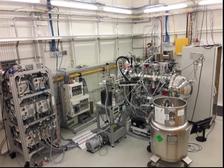The photoelectron spectroscopy instrument installed at the PETRA III beamline P22 was built at Stockholm University and allows studies of catalyst surfaces under high pressures. (Credit: Univ. Stockholm / Peter Amann)
A research team from Stockholm University, in collaboration with DESY and the Montanuniversität Leoben in Austria, has succeeded for the first time in investigating the surface of iron and ruthenium catalysts in the formation of ammonia from nitrogen and hydrogen; the results have been published in the scientific journal Nature. With exact knowledge of how these catalysts work, it may be possible to identify even more efficient materials for the process. This in turn could lead to greater sustainability in the currently very CO2-intensive chemical industry.
Ammonia, produced in the Haber-Bosch process, is currently one of the most essential base chemicals for the world to produce fertilizers, with an annual production of 110 million tones. The journal Nature proposed in 2001 that the Haber-Bosch process was the most critical scientific invention for humankind during the 20th century, since it has saved around 4 billion people’s lives by preventing mass starvation. An estimation of the nitrogen content in our bodies’ DNA and proteins shows that half of the atoms can be derived from Haber-Bosch.
“In spite of three Nobel Prizes (1918, 1931, and 2007) for the Haber-Bosch process, it has not been possible to experimentally investigate the catalyst surface with surface-sensitive methods under real ammonia production conditions; experimental techniques with surface sensitivity at high enough pressures and temperatures had not been achievable. Consequently, different hypotheses about the state of the iron catalyst as being metallic or in a nitride, as well as the nature of the intermediate species of importance to the reaction mechanism, could not be unambiguously verified”, says Anders Nilsson, professor of Chemical Physics at Stockholm University.
“What enabled this study is that we have built a photoelectron spectroscopy instrument in Stockholm that allows studies of catalyst surfaces under high pressures. Thereby, we have been able to observe what happens when the reaction occurs directly”, says David Degerman, Postdoc in Chemical Physics at Stockholm University. “We have opened a new door into understanding ammonia production catalysis with our new instrument where we now can detect reaction intermediates and provide evidence for the reaction mechanism.”
"The innovative spectroscopy instrument from Stockholm University in combination with the beam parameters of PETRA III now enables in-operando experiments on catalysts at pressures ten times higher than at other synchrotron light sources," says Christoph Schlueter (DESY), head of PETRA III beamline P22. “To have our Stockholm instrument at one of the brightest x-ray sources in the world at PETRA III at DESY in Hamburg has been crucial to conduct the study”, says Patrick Lömker, Postdoc at Stockholm University. “We can now imagine what we will be able to examine in the future with even brighter sources when the machine upgrades to PETRA IV”.
"The challenging measurements finally clarify important open questions about the active species in ammonia synthesis," says Christoph Schlueter. During the investigations, the research team discovered that the catalyst surface does not form nitrides, but remains metallic under all conditions in which ammonia is produced. The surface of ruthenium - a more active catalyst than iron, but much more expensive - remains completely free of nitrogen species, which limits its activity. The first dissociative step, in which the nitrogen molecules are completely broken down, determines the speed of the overall reaction. At higher temperatures, iron behaves similarly to ruthenium, but here too the reaction rate is partly controlled by the process of attaching hydrogen atoms to the nitrogen species. At lower temperatures, the overall rate decreases and the limiting reaction step is completely linked to this hydrogenation process.
“We now have the tools to conduct research leading to new catalyst materials for ammonia production that can be used better to fit together with electrolysis-produced hydrogen for the green transition of the chemical industry”, says Anders Nilsson, Professor at the Stockholm University.
“It is inspiring to conduct research on a topic that is so linked to a scientific success story that has helped humanity tremendously. I am eager to continue research to find new catalysts that can lessen our dependence on fossil sources. The chemical industry alone accounts for 8% of the world-wide CO2 emissions”, says Bernadette Davies, PhD student in Materials Chemistry at Stockholm University.
“The long-term prospect of carrying out ammonia production through an electrocatalytic alternative that is directly driven by solar, or wind electricity is most appealing, and now we have tools to scientifically assist in this development”, says Sergey Koroidov, Researcher at Stockholm University.
The research was conducted in collaboration with DESY and the Montan University in Austria. The study included former employees of the Stockholm University, Chris Goodwin, Peter Amann, Mikhail Shiplin, Jette Mathiesen and Gabriel Rodrigez.
(Partly from DESY News)
Reference:
"Operando probing of the surface chemistry during the Haber–Bosch process", Christopher M. Goodwin et al, Nature (2024)
DOI: 10.1038/s41586-023-06844-5







